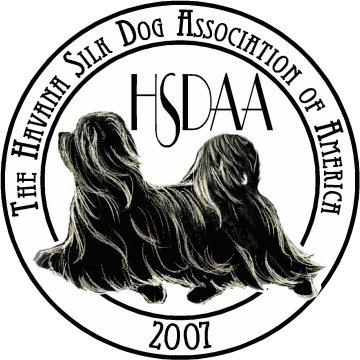The Many Colors of Silks
Havana Silk Dogs come in a variety of colors. Our Standard accepts all colors as long as the pigment on the nose and eye rims is black, except on the chocolate dog, which has dark brown pigment. Dilute blue pigmentation is the result of gene dilution and is not accepted in our Standard. The various coat colors that we most commonly see in our Silks are set forth below, although any color or combination of colors, with the exception of Merle, as long as the nose is black, or dark brown on the chocolate dog, is equally acceptable. Merle is a disqualification under our standard.
Black: Pure deep black. When black is modified by other genes such as the silvering gene, it may develop overtones as the dog matures.
Blue: Blue puppies are born black but lighten to varying shades of grey over a period of years. There is more than one form of blue. One is caused by a “premature greying” gene that results in a gradual depigmentation of black hairs giving a salt/pepper appearance. The other is caused by a silvering gene that limits the expression of black pigment over a period of time. This dog usually becomes a softer, bluish grey. Dogs with two copies of either of the silvering genes will turn very early and are called Silver. In all cases, pigment in the blue dog is black.
Chocolate: preferably a deep rich brown.
Cream: Basically this is an off-white dog. Puppies usually show some color which, in the adult, becomes more of an off-white. These dogs may appear white at first notice but, if parked next to a true white dog, are not really white.
Fawn: Deeper than cream with a cooler shade of tan.
Gold: Rich, warm color from caramel to toffee. There is a definite warm, yellow cast to the coat.
Red: A rich, warm color, similar to gold but with more intense color ranging from apricot to orange-red to mahogany. There are definite red highlights to the coat.
Patterns
The base colors of the Silk Dog are often modified by a variety of patterns that can change the character of the base color. All of the above colors can also have the following patterns except that pointed dogs are only black or chocolate.
White Markings: This is a two-colored coat. A dog with white markings is a predominantly colored dog with small patches of white typically on toes, chest, and chin. Sometimes there are white markings on the forehead or body.
Irish Pied: A two-colored coat with more than 50% colored. There is a specific pattern of white markings. The underbelly, lower legs and tail tip are white. There is also white on the chest, a full or partial collar of white around the neck. The face may also have a blaze or white muzzle.
Piebald or Parti: A two-colored coat that is predominantly white (over 50%) broken by irregular patches of color. The patches may be of any color. A piebald dog with less than 10% color is often called an ‘extreme piebald.’ The colored patches on these dogs are almost always limited to the head/ears.
Belton: This is a pattern that results from the ‘ticking’ gene. This modifier causes white areas of the dog to develop colored spots which then grow colored hairs. A black piebald or parti belton dog that carries the ticking gene will start out with white areas but, over time, these will end up with a mixture of colored and white hairs causing the formerly white areas to look grey/silvery/sooty or salt/peppery.
Brindle: is a pattern of bands, or stripes, of dark color on a base of lighter color, similar to tiger striping. These bands, or stripes, are evident from birth but blur in a long coated dog as the coat grows.
Agouti/Wild: is another banding pattern, but in this one, individual hairs grow out with alternating bands of color on the shaft. These dogs change color with interesting regularity depending on what color happens to be growing out today.
Points: Points are a specific pattern of light and dark coat. The points pattern is easily seen in the Doberman. The lower legs, under tail around perineum, forechest, cheeks and eyebrows are light. Points can be tan, cream, or silver and may start out richer but lighten with age. The points can be clear or have dark hairs mixed in to them. Dogs with both points and white markings are often called “Tri-color.” Points can be extensive or subtle and are not always evident in all areas. Both black and chocolate dogs can be pointed.
Sable: The sable pattern typically appears as an overlay or tipping on a lighter color coat and the amount of darker hair on the lighter coat varies greatly. Typically sables are born very dark, sometimes almost black, and the lighter undercoat develops with age. The undercoat on a sable can be cream, gold or red. The extent of tipping varies from only tipping on the ears to heavy sabling on the head, back and tail. Typically the chest, stomach and legs are the lighter coat color without tipping. Some sables also appear to have darker masks while others do not.around perineum, cheeks and eyebrows are light. Points can be tan, cream, or silver and may start out richer but lighten with age. Dogs with both points and white markings are often called “Tri-color“. Points can be extensive or subtle and the facial points may be hidden by black masking.
For more information on Havana Silk Dog color genetics, read
“Color Genetics and Testing: What Your Silk Can Produce” by Dionne Franklin, published in the Winter 2012 Silk Road.
